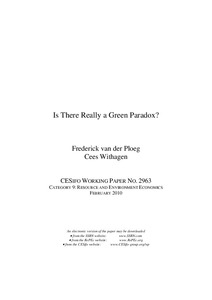Is there really a green paradox?
"The Green Paradox states that, in the absence of a tax on CO2 emissions, subsidizing a renewable backstop such as solar or wind energy brings forward the date at which fossil fuels become exhausted and consequently global warming is aggravated. We shed light on this issue by solving a model of...
| Main Authors: | , |
|---|---|
| Institution: | ETUI-European Trade Union Institute |
| Format: | TEXT |
| Language: | English |
| Published: |
Munich
2010
CESifo |
| Subjects: | |
| Online Access: | https://www.labourline.org/KENTIKA-19185289124919034619-is-there-really-a-green-parado.htm |
| Summary: | "The Green Paradox states that, in the absence of a tax on CO2 emissions, subsidizing a renewable backstop such as solar or wind energy brings forward the date at which fossil fuels become exhausted and consequently global warming is aggravated. We shed light on this issue by solving a model of depletion of non-renewable fossil fuels followed by a switch to a renewable backstop, paying attention to timing of the switch and the amount of fossil fuels remaining unexploited. We show that the Green Paradox occurs for relatively expensive but clean backstops (such as solar or wind), but does not occur if the backstop is sufficiently cheap relative to marginal global warming damages (e.g., nuclear energy) as then it is attractive to leave fossil fuels unexploited and thus limit CO2 emissions. We show that, without a CO2 tax, subsidizing the backstop might enhance welfare. If the backstop is relatively dirty and cheap (e.g., coal), there might be a period with simultaneous use of the non-renewable and renewable fuels. If the backstop is very dirty compared to oil or gas (e.g., tar sands), there is no simultaneous use. The optimum policy requires an initially rising CO2 tax followed by a gradually declining CO2 tax once the dirty backstop has been introduced. We also discuss the potential for limit pricing when the non-renewable resource is owned by a monopolist." |
|---|---|
| Physical Description: | 32 p. Digital |

